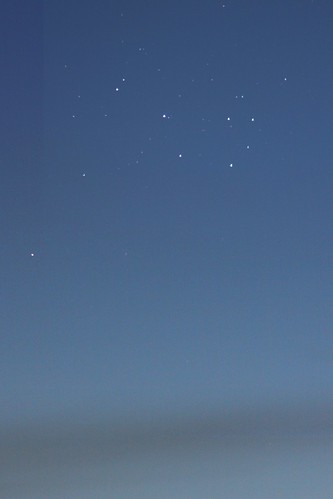The sun is setting at around 5pm during November, so here is how to enjoy the long winter nights!
The highlight of the evening sky is the planet Jupiter, visible low in the south to south-west up until 10.30pm in the evening. Take a look at Jupiter with binoculars, or a small telescope, and see how many of Jupiter's Moons you can spot – just as Galileo did 400 years ago. You should be able to see up to four moons, and if you take another look just a few hours later, you may be able to notice that the moons have moved a bit in just that very short period of time.

The planets Uranus and Neptune are also visible in the evening sky, but they are just-too-faint to be seen with the unaided eye, which is why these two planets were not discovered until after the invention of the telescope.
Early in the evening, looking towards the west, you can still see the summer triangle of stars – Vega, Altair and Deneb – until about 9pm (see the chart to the right; click on it to see it full size). Within the triangle, you can see the remains of two dead stars using a telescope – the ring and dumbbell nebulae. There is also a beautiful double star called Albireo within the triangle.

This is also a great time of year to see the Andromeda galaxy – the most distant object that you can see with your own eyes! It may be 2.25 million light-years away, but it is quite easy to find. Just go somewhere dark, away from the light pollution and inefficient lighting of our towns and cities, and look for the square of Pegasus. The square can be found by looking towards the South, about half way up the sky. It’s quite a big square – just bigger than your hand at arms length. Look towards the star that makes the top-left corner of the square, then follow two bright-ish stars up towards the top left, and then follow two more slightly fainter stars towards the top right (as in the map, right), and just there is the Andromeda galaxy! The W-shaped constellation of Cassiopeia also usefully “points” towards the galaxy.

And it is huge! It is actually six times the diameter of the full Moon, but it appears faint because it is so far away, and so with our own eyes we can only see the bright centre of this massive city-of-stars. For the best view, take a look through binoculars (telescopes usually have too high a magnification for you to see this galaxy clearly).

Now look to the left of the square of Pegasus, about 4 times its size, and you will see a bright red giant star called Aldebaran. Just to the top-right of Aldebaran, you’ll be able to see the Pleiades star cluster, also know as the seven sisters because you can see up to seven stars with your own eyes (pictured left as a wide-angle view, and right as a close-up photograph). This cluster is a beautiful sight through binoculars, where you can see up to 50 stars. Again, don’t use a telescope, since you will only be able to see one or two stars at a time – low magnification is what you need for a cluster that appears bigger than the Moon in the night sky.
You can get some very easy-to-use and clear star maps from either skymaps.com, or by using the excellent (and free) Stellarium Planetarium software.


